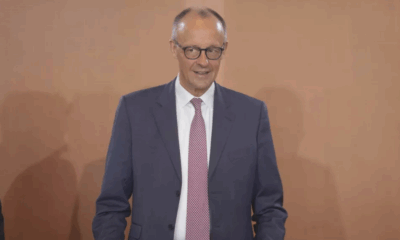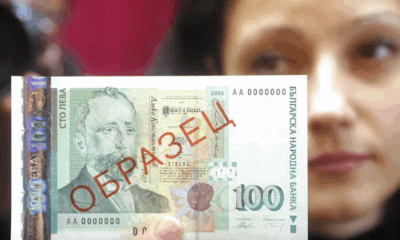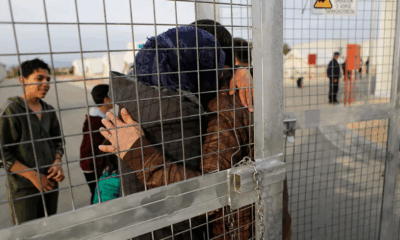News
EU Divided Over Response to Trump’s Tariff Threats
While the European Union presents a united front against U.S. President Donald Trump’s newly announced tariffs on steel and aluminum, internal divisions are emerging over the best course of action. Some member states, led by France, are pushing for swift retaliatory measures, while others, including Germany, Italy, and Hungary, advocate for a more cautious approach focused on dialogue.
Trump’s Tariffs Spark Urgent EU Talks
Trump’s latest tariff decision, announced Monday, includes a 25% levy on imported steel and aluminum, citing national security concerns. The executive order, set to take effect on March 12, was followed by another announcement on Thursday: a plan for reciprocal tariffs on U.S. trading partners, to be determined on a country-by-country basis in the coming weeks.
In response, the European Commission vowed on Friday to react “firmly and immediately”, setting the stage for internal debate within the EU over how to proceed.
Hawks vs. Doves: A Divided Approach
Following an emergency video conference of EU trade ministers on Wednesday, the rift between hawks and doves became apparent.
- France, leading the hawkish camp, argues that strong and immediate retaliation is necessary to prevent excessive concessions to the U.S. “Every U.S. measure announced calls for an immediate response,” one official told Euronews.
- Germany, Italy, and Hungary, in contrast, prefer a more measured approach, advocating for continued negotiations with Washington rather than hastily imposing countermeasures. A diplomat from this group emphasized the importance of avoiding a tit-for-tat trade war.
Hungary, where Prime Minister Viktor Orbán maintains close ties with Trump, is pushing for no retaliatory action before March 12. Meanwhile, Italy insists on keeping diplomatic channels open before resorting to tariffs.
EU’s History of Retaliation and Future Strategy
The EU has previously responded to Trump-era tariffs. In 2018, the bloc countered U.S. duties on European steel (25%) and aluminum (10%) with €2.8 billion in tariffs on American goods. A temporary truce was brokered under President Joe Biden, but that agreement expires at the end of March 2024.
Since then, the EU has bolstered its trade defenses, introducing anti-coercion measures that allow restrictions on public procurement, services, and intellectual property rights in retaliation to trade threats.
Strengthening Global Trade Partnerships
Amid tensions with the U.S., the EU is working to expand its global trade network. Recent agreements include:
- A free trade deal with Mercosur nations (Argentina, Brazil, Paraguay, Uruguay)
- A trade pact with Switzerland, finalized in December
- A renewed agreement with Mexico, completed in January
- Reopened negotiations with Malaysia
Later this month, all EU Commissioners will travel to India for talks on a strategic partnership, including discussions on trade cooperation.
Outlook: Trade Tensions or Compromise?
With Trump signaling broader trade policy changes, EU officials, including Trade Commissioner Maroš Šefčovič, have warned that the bloc must prepare for more than just steel and aluminum tariffs.
Following a meeting with Canadian Prime Minister Justin Trudeau, European Council President António Costa reinforced the EU’s preference for diplomacy, tweeting: “Trade agreements are better than trade tariffs.”
Whether the EU opts for immediate retaliation or ongoing negotiations, its ability to maintain a cohesive response will be crucial in shaping its economic future amid a shifting global trade landscape.
News
Two Dead, Nearly 200 Injured as PSG Title Celebrations Turn Violent Across France

What began as jubilant celebrations of Paris Saint-Germain’s historic UEFA Champions League victory ended in violence and tragedy in parts of France, with two people killed and nearly 200 injured during street festivities that spiraled out of control.
Authorities confirmed on Sunday that a 17-year-old boy was fatally stabbed in the southwestern town of Dax during a PSG street gathering, while in Paris, a man died after his scooter was struck by a car amid the crowded celebrations. Both incidents are currently under investigation.
The unrest followed PSG’s dramatic win in Munich, where the club secured its first-ever Champions League title, marking a milestone in French football history. While fans across the country took to the streets to celebrate, several areas descended into violence.
According to the French Interior Ministry, a total of 294 people were arrested nationwide as of 2 a.m. Sunday. Of the nearly 200 injured, 21 were police officers—18 of them in Paris alone. One officer remains in a medically induced coma after being struck in the face by a firework.
Interior Minister Bruno Retailleau condemned the violence in a statement on social media. “True PSG fans are celebrating a magnificent achievement. Meanwhile, barbarians have taken to the streets to commit crimes and provoke law enforcement,” he said. “It is unacceptable that people cannot celebrate without being endangered by a violent minority.”
Despite the unrest, the majority of gatherings were peaceful, authorities noted, with large crowds celebrating the historic win in cities including Marseille, Lyon, and Lille.
The PSG squad returned to Paris from Munich on Sunday afternoon aboard a Qatar Airways charter flight, arriving at 4 p.m. The team is expected to continue celebrations in the capital with tens of thousands of fans, under heightened security measures.
The violent turn of events has reignited debate in France over crowd control during major sporting celebrations, and how best to ensure public safety without dampening national enthusiasm.
PSG’s Champions League triumph marks a defining moment for the club, which has long pursued European glory. As the team prepares for a hero’s welcome, officials are urging fans to celebrate responsibly and respect public safety.
News
Ukraine Launches Major Drone Assault on Russian Airfields, Hits Over 40 Strategic Bombers

Ukraine’s Security Service (SBU) has claimed responsibility for a large-scale drone strike on four Russian air bases over the weekend, targeting dozens of strategic bombers across vast swaths of Russian territory — from Siberia to the Arctic.
According to Ukrainian officials, the operation, codenamed “Spiderweb” (Pavutyna), was launched on June 1 and struck 41 long-range bombers stationed at airfields in Russia’s Ryazan, Ivanovo, Irkutsk, and Murmansk regions. The attack is being hailed by Kyiv as one of its most ambitious and far-reaching strikes since the beginning of Russia’s full-scale invasion.
“Enemy strategic bombers are burning en masse in Russia,” a senior SBU official said, noting that the operation was specifically designed to cripple Moscow’s airstrike capabilities. “This is a large-scale special operation aimed at destroying enemy bomber aircraft.”
The four airfields targeted were Dyagilevo in the Ryazan region, Ivanovo in central Russia, Belaya air base in Irkutsk — over 4,000 kilometers from the front lines — and Olenya air base on the Kola Peninsula near the Arctic, roughly 2,000 kilometers from Ukraine’s border.
Ukrainian officials described the complex logistics of the operation, which involved covertly transporting drones deep into Russian territory, hiding them until the time of launch, and remotely executing the strikes. While specific details remain classified, Ukraine previously revealed it had developed drones with a flight range of up to 3,000 kilometers, enabling long-range operations like this.
Satellite imagery analyzed after the attack shows the presence of several high-value Russian aircraft types at the affected bases, including the Tu-95, Tu-22M3, Tu-160, and A-50 radar planes. These aircraft have been central to Russia’s long-range missile campaign against Ukraine.
The Tu-22M3, for example, is capable of carrying Kh-22 and Kh-32 cruise missiles at speeds exceeding Mach 4. The Tu-95, a Cold War-era bomber once designed to carry nuclear weapons, has been retrofitted to launch conventional cruise missiles. The A-50 aircraft provides airborne radar surveillance and target coordination for Russian forces.
The scale of the strike underscores Ukraine’s growing long-range capabilities and signals a shift in Kyiv’s strategy to disrupt Russian air operations at their source. President Volodymyr Zelenskyy said he had held meetings with the Ministries of Defense and Foreign Affairs, along with the General Staff and SBU, to coordinate further defense and counter-offensive planning.
There has been no immediate official response from Moscow regarding the extent of damage caused.
News
German Chancellor Merz to Meet President Trump in Washington Amid Global Tensions
-

 Business1 year ago
Business1 year agoSaudi Arabia’s Model for Sustainable Aviation Practices
-

 Business1 year ago
Business1 year agoRecent Developments in Small Business Taxes
-

 Politics1 year ago
Politics1 year agoWho was Ebrahim Raisi and his status in Iranian Politics?
-

 Business11 months ago
Business11 months agoCarrectly: Revolutionizing Car Care in Chicago
-

 Business11 months ago
Business11 months agoSaudi Arabia: Foreign Direct Investment Rises by 5.6% in Q1
-

 Technology1 year ago
Technology1 year agoComparing Apple Vision Pro and Meta Quest 3
-

 Politics1 year ago
Politics1 year agoIndonesia and Malaysia Call for Israel’s Compliance with ICJ Ruling on Gaza Offensive
-

 Sports10 months ago
Sports10 months agoKeely Hodgkinson Wins Britain’s First Athletics Gold at Paris Olympics in 800m






























